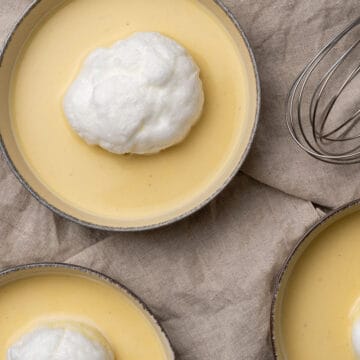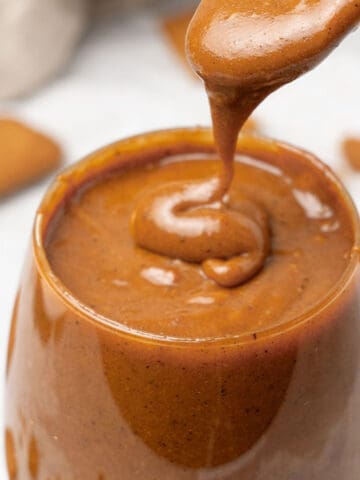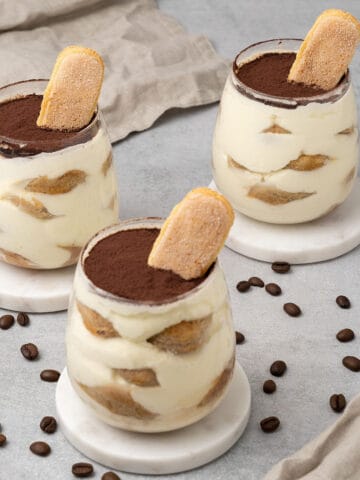Also known as île flottante in French, a floating island is a light, fluffy, and creamy classic French dessert that is in fact, no-bake and super easy. Made with milk, sugar, egg, and vanilla, the floating island dessert isn't just simple to make but also gluten free! Top it with your favorite garnish, such as nuts, caramel, chocolate, or fruit, and you'll have an elegant, eye-catching sweet treat guaranteed to be a crowd-pleaser.

Jump to:
📖 What dessert is called a floating island?
If there's one dessert that I remember fondly from my childhood, it is this floating island dessert. Growing up, my mom often made floating island pudding to satisfy our sweet tooth after dinner. In fact, my mom knows very little about French pastries so I thought it was a Hungarian dessert!
So what is a Floating island dessert? The Floating Island is, in fact, a classic French dessert. The name comes from its resemblance to a "floating island" once you place the poached egg on top of a creamy pouring custard (also known as creme anglaise). It also goes by the French name oeufs à la neige, which translates to "snow eggs" in English. In Hungary and Romania, it goes by the name of "bird's milk." It is often served after dinner or as a decorative party dessert during the holidays.
There are two main components to making the dessert: Preparing the poached meringue and the creme anglaise custard. All you need to prepare this old fashioned floating island recipe is four basic kitchen ingredients that are likely already in your pantry: egg, milk, sugar, and vanilla.
Despite their fancy and delicate look, floating islands are pretty simple to make. However, they require patience and precision. Following the recipe exactly as written is crucial if you want a flawless outcome.

🌟 Why this is the best recipe
- It is straightforward to make - You will not need any unique ingredients or fancy equipment to make this floating island recipe. Everything you need to make this recipe is likely already in your kitchen!
- It is quick - The recipe will come together in less than an hour, and no baking is required!
- You don't need to be an expert - Don't let its fancy and delicate look fool you! Even beginners can make this delicious dessert by carefully following the steps I provide and being mindful of the details. No baking is required!
- It is fool-proof - My floating island dessert recipe uses a precise technique and measurements to eliminate the chances of something going wrong. Following this recipe exactly as written, you'll end up with a perfect floating island.
- It is incredibly delicious - I use nothing but the highest quality and most flavorful ingredients in my recipe, ensuring that you get the delightful and crave-worthy dessert that you expect. Imagine silky custard with deep vanilla flavor and airy fluffy poached meringue. For me, floating island is the most perfect dessert!
📝 Ingredient notes


- Egg - The egg white will need to be separated from the egg yolk for this recipe, which may take some practice. You will need the egg white from approximately three eggs for the poached meringue. Save the remaining egg yolk for your Creme Anglaise pouring custard, which requires the yolk of approximately six eggs (or more if you desire a thicker custard). You can always save the egg yolk that remains after you make the pouring custard for another recipe, such as my easy crème brûlée recipe or my creamy Sicilian ricotta pie!
- Sugar - Plain, white granulated sugar is all you need for this recipe. Take a look at my sugar guide to learn more about the different types of sugar and how to use them in baking.
- Whole Milk - For the best results and taste, use milk with high-fat content. For this recipe, I use milk with 3% fat.
- Vanilla - If you want the deepest, most delicious vanilla flavor, use pure vanilla versus artificial vanilla. I personally love and recommend Nielsen Massey or why not make your own vanilla extract?
- (Optional) Corn Starch - While the custard in the floating island dessert is best when slightly thin, some may prefer a thicker custard. In that case, you can use corn starch as a thickening agent.
🛒 You’ll find detailed measurements for all ingredients in the printable version of the Recipe Card at the bottom of this post
👩🍳 How to make this recipe
Making poached meringue is easy but requires extra attention and care throughout the process. The last thing you want is a sinking island versus a floating one!
1. How to make poached meringue
- Carefully separate your egg yolks from your egg whites.
- Use your electric hand mixer to whip your separated egg white with the sugar and make a meringue. During the process, you want to gradually add the sugar. Stop whipping once as soon as it begins to get shiny and reach early stiff peaks, no need to super stiff peaks, in fact, stop before you reach that. Overwhipping the meringue could result in deflating later in the poaching process.
- Once you are done whipping, carefully move your meringue into a piping bag.
- Bring your milk to a simmer over low-medium heat using a large saucepan.
- As the milk simmers, pipe the meringue into a ladle until it becomes the shape of a ball. The meringue ball will become your "island." Then, gently place the meringue "island" into the simmering milk. If you don't have a ladle, you can use a large slotted spoon and gently place it into the warm milk.
- Lower the heat of the simmering milk to low. Then, cook the meringue for two minutes on both sides. The meringue island will expand as you cook, so do not place too many in the simmering milk at once.
- Once the meringue is well-poached (you can tell when it holds its shape), remove it from the milk with your ladle or slotted spoon. Then, drain it and let it rest on a paper towel. Set the drained milk aside to use in the next part of the recipe.
- After it is completely drained, place it in the refrigerator for at least two hours.
💡 Top Tip: For the best results, create your floating meringue islands in batches, giving each plenty of its own space. The meringue will expand as they cook, so you want to take care not to overcrowd the pan. I recommend only making two or three at a time.

2. How to make crème anglaise
Make sure to check out my detailed Creme Anglaise recipe! Creme Anglaise is a delicious vanilla custard and the base of many delicious French desserts. With only four ingredients (milk, sugar, egg, and vanilla), it is super easy to make. However, it requires careful attention to the temperature so that you don't overcook it and end up with scrambled eggs in your custard!
- In a large bowl, add your sugar and room temperature egg yolk. With the help of a hand whisk, whisk the two ingredients together until slightly fluffy. This process should take no more than a minute or two.
- Using the drained milk from the poached meringue, measure 500g of milk, add more if necessary.
- Bring the milk and vanilla to a simmer in a saucepan over medium heat. As soon as it begins to simmer, remove it from the heat. Do not let it reach a boil, as it will be too hot for the following step.
- Slowly pour the warm milk over the egg yolk mixture as you use your hand whisk to mix the two vigorously. Make sure you do so very slowly and are constantly stirring to temper your egg yolks effectively.
- Next, pour the mixture back into the saucepan and cook over medium heat. Use your digital thermometer to monitor when the mixture reaches 82C / 180F.
- As soon as the cream reaches 82C / 180F, remove it from the heat. Cooking it any further will cause the mixture to curdle, so pay close attention!
- Let the custard come to a chill in the refrigerator before using it as required in the recipe.
💡 Top Tip: Your pouring custard is considered done when it can coat the back of a spoon and not rejoin when you run your finger down the middle of the cream.

3. How to serve a floating island dessert
The best way to serve your floating islands is chilled and in individual bowls. If you really want to get fancy, you can garnish your island with your favorite topping.
After both the custard and the meringue island have chilled, pour the custard into an individual bowl. Next, gently place one poached meringue island on top of the custard.
💡 Top Tip: For an even more eye-catching dessert and an extra blast of flavor, garnish your floating island with fruit, and roasted nuts, or drizzle with your favorite sauce, such as chocolate or caramel sauce.

🥣 Equipment Notes
Precision and accuracy are critical when it comes to producing error-free, problem-free baking results. For the best accuracy and to ensure your recipe ends up exactly as you expected, follow this recipe exactly as written and measure all of your ingredients with a digital scale.
A rubber spatula comes in handy when stirring together the ingredients of your pouring custard as it cooks. In addition, using a spatula helps to prevent air bubbles from forming.
Use a hand whisk to whisk together your wet and dry ingredients thoroughly and to temper your egg yolks effectively.
A digital thermometer is a key player in the process and will ensure that your custard mixture does not get too hot. Going above the indicated temperature will cause the eggs in the recipe to turn into scrambled eggs.
You'll need an electric hand mixer to whip your egg white and sugar together into stiff peaks. If you have the choice between a hand mixer and a stand mixer, always go with the hand mixer to prevent your meringue from getting overwhipped. However, if a stand mixer is all you have, only use the whisk attachment and do not walk away during the whipping process.
🎓 Expert tips
- For smoother results and ease of mixing the ingredients, always start with room temperature eggs.
- Go slow and be extra careful when separating the egg white from the egg yolk to prevent the two from mixing. If, at any point, the two mix together, you will need to start again as it is not possible to whip up the meringue with egg yolk in it
- When you whip your egg white and sugar together to make the meringue, I recommend that you start at a low speed and gradually increase it, also add the sugar gradually
- Do not over whip the meringue as that would encourage the "islands" to deflate after poaching
- When pouring the hot milk mixture over the egg yolk mixture, pour very slowly and in increments, taking care to whisk thoroughly before adding more milk.
- To prevent your custard from curdling, always use a digital thermometer to ensure that the egg yolk and milk mixture temperature doesn't exceed 82C / 180F.
- If you find that your pouring custard is lumpy or starts to curdle, you can use an immersion blender to smooth out the chunks. Then pass the custard through a fine mesh sieve to ensure no lumps remain.
- If the color of your custard is important to you, be mindful of the source of your eggs. Fresh farm eggs tend to provide bright yellow color cream, while cheaper supermarket eggs tend to give a paler cream.
- If you want a richer custard sauce, substitute half of the milk with a 36% fat heavy cream or use corn starch just as I explain in my pastry cream recipe
❓Recipe FAQs
If by chance you are left with extras of this delicious dessert, you can store your leftovers in the refrigerator in separate, airtight containers for up to 2-3 days. It is best to store the meringue and custard separately and then reassemble them when ready to serve them.
Unfortunately, you cannot freeze the floating island dessert. While some chefs say you can freeze the custard, I do not recommend doing so, as freezing it will significantly change the texture and taste when thawed. Your meringue is also best made the day of to maintain its freshness and shape.
Yes, you can make the custard in the recipe up to 2-3 days in advance. It will also have the best taste and consistency when chilled overnight in the refrigerator. To ensure it stays fresh, store it in an airtight container.
To prevent a film from forming over the custard, cover it with plastic wrap, making sure that the wrap is touching the custard. I recommend waiting until the day you plan to serve the dessert to make the meringue, as you want it to keep its fresh, fluffy shape when it is served.
The Creme Anglaise custard used in floating dessert recipes tends to have a thinner consistency, so no thickener is required. However, if you prefer a thicker custard base for your island, you can increase the amount of egg yolk in the recipe or use corn starch as I do in my pastry cream recipe.
For the best taste, the floating island dessert is best served chilled. However, some may prefer to have their custard served cold while the poached meringue remains lukewarm. If you like the warmer option, simply prepare and chill the custard well in advance (overnight for the best results) and place the lukewarm poached meringue on top when ready to serve the dessert.
🧁 More dessert recipes

Floating island dessert (VIDEO)
Ingredients
For the poached meringue
- 90 g Egg white approx. the white of 3 eggs
- 30 g (¼ cups) Granulated sugar
- 750 g (3 cups) Whole Milk 3% fat
For the Creme Anglaise
- 500 g (2 cups) Milk 3% fat
- 80 g (½ cups) Granulated sugar
- 120 g (½ cups) Egg yolk approx. yolk of 6 eggs
- 2 teaspoon Vanilla bean paste or vanilla extract
US customary cup measurement is an indicative figure only. Measure the ingredients with a digital scale by weight (gram). Baking is art but also science which requires precision and accuracy.
Instructions
Poached egg white
- Using an electric hand mixer, whip egg white with sugar until early stiff peaks. Add the sugar gradually and stop as soon as the meringue is shiny and close to stiff peaks.
- Move meringue into a piping bag.
- In a large saucepan heat milk on low-medium heat. When milk is simmering, pipe the meringue into a ladle so it becomes like a ball shape, then gently release the meringue into the warm milk.
- Alternatively, use a large spoon and spoon the meringue balls into the warm milk.
- Turn milk into low heat and cook the meringue "islands" for 2 minutes on both sides. The meringue should puff up so be mindful of how many you place into the milk at once.
- Once the meringue is well poached, drain it and let it rest on paper towel, then refrigerate.
Custard
- In a large enough bowl, with the help of a Hand whisk, whisk together sugar and egg yolk until slightly fluffy for about 1-2 minutes.
- Drain the milk you used to poach the meringue and measure it again to 500g (add more milk if necessary).
- Bring milk and vanilla to a simmer in a saucepan on medium heat then remove it as soon as it starts simmering. Make sure it is simmering but not boiling.
- Pour the warm milk over the egg yolk mixture slowly while whisking vigorously with a Hand whisk. This stage is effectively tempering the egg yolks.
- Pour the mixture back into the saucepan and cook on medium heat until the temperature reached 82C / 180F.
- Remove the cream from the stove as soon it reaches the desired temperature. Do not cook it further as the mixture will curdle.
- Chill the custard before serving.
Serving
- Once the custard chilled as well as the meringue is chilled, pour the custard into an individual bowl, then place one poached meringue on top.
- Any leftover should be stored refrigerated for 2-3 days; the meringue and custard separately.
Notes
- Measure your ingredients with a Digital scale for accuracy
- High fat content milk and cream and pure vanilla are the heart of making Crème Anglaise
- Fresh, farm eggs will provide bright yellow color cream, while cheaper supermarket eggs will result in a pale cream
- Make sure you read my Expert tips section above to maximize your success. A short recipe alone is not able to cover all the necessary details, and science behind baking.
- Do not over whip the meringue before poaching as that is the most common reason for deflating later
- Do not heat the custard mixture further than 82C / 180F as the egg will curdle
- If you want a thicker sauce, increase the egg yolk in the recipe or use corn starch as my pastry cream recipe








Susan
I’ve never heard about this dessert before but saw it on your Instagram and so happy that I tried it! It’s the best dessert I’ve ever made, so light and elegant and delicious. Love it